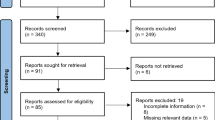Abstract
A computer-aided model for the prediction of pseudoallergic reactions was developed using prospective data collected from 581 patients in a controlled clinical trial examining pseudoallergic reactions to the plasma substitute Haemaccel (outdated formulation). The multivariate analysis of 22 proposed risk factors was performed using Bayes theorem. This enabled the accurate prediction of 86% of the patients who had a systemic reaction. The clinical use of such system would enable a selection of patients to receive the effective prophylactic measure of pretreatment with H1 plus H2-receptor antagonists.
Similar content being viewed by others
References
A. Doenicke, M. Ennis and W. Lorenz,Histamine release in anesthesia and surgery: a systematic approach to risk in the perioperative period, Int. Anesthesiology Clinics23, 41–66 (1985).
M. C. Laxenaire, J. Manel, J. Borgo and D. A. Moneret-Vautrin,Predisposing factors of histamine release: prospective study in an anaesthetic patient population, Ann. Anesth. Ranim.4, 158–166 (1985).
W. Lorenz, A. Doenicke, B. Schöning, C. Ohmann, B. Grote and E. Neugebauer,Definition and classification of the histamine-release response to drugs in anaesthesia and surgery: studies in the conscious human subject, Klin. Wochenschr.80, 896–913 (1982).
B. Schöning, W. Lorenz and A. Doenicke,Prophylaxis of anaphylactoid reactions to a polypeptidal plasma substitute by H 1-plus H2-receptor antagonists: synopsis of three randomized controlled trials, Klin. Wochenschr.80, 1048–1055 (1982).
C. Ohmann, W. Lorenz, H. Stöltzing and K. Thon,Grundlagen der Risikoforschung in der Chirurgie: Definition, Berechnung und klinische Anwendung auf das Problem der oberen Gastrointestinalblutung, Chirurg.58, 344–351 (1987).
G. H. Hall,The clinical application of Bayes' theorem, Lancetii, 555–557 (1967).
D. M. Titterington, G. D. Murray, L. S. Murray, D. J. Spiegelhalter, A. M. Skene, J. D. F. Habbema and G. J. Gelpke,Comparison of discrimination techniques applied to a complex data set of head injured patients, J. Roy. Statist. Soc.A 144, 145–175 (1981).
C. OhmannProzesse chirurgischer Entscheidungsfindung bei der oberen Gastrointestinalblutung, Habilitation Thesis, University of Marburg (1986).
W. Lorenz and A. Doenicke,A prophylactic principle in anesthesiaa and surgery against histamine-release responses of any degree of severity, New Eng. Reg. Allergy Proc. Part I6 37–57 (1985), Part II6 174–194 (1985).
Author information
Authors and Affiliations
Additional information
Supported by a grant from the Deutsche Forschungsgemeinschaft (Lo 199/14-2).
Rights and permissions
About this article
Cite this article
Ennis, M., Ohmann, C., Lorenz, W. et al. Prediction of risk for pseudoallergic reactions and histamine release in patients undergoing anaesthesia and surgery: A computer-aided model using independence-Bayes. Agents and Actions 23, 366–369 (1988). https://doi.org/10.1007/BF02142589
Issue Date:
DOI: https://doi.org/10.1007/BF02142589




